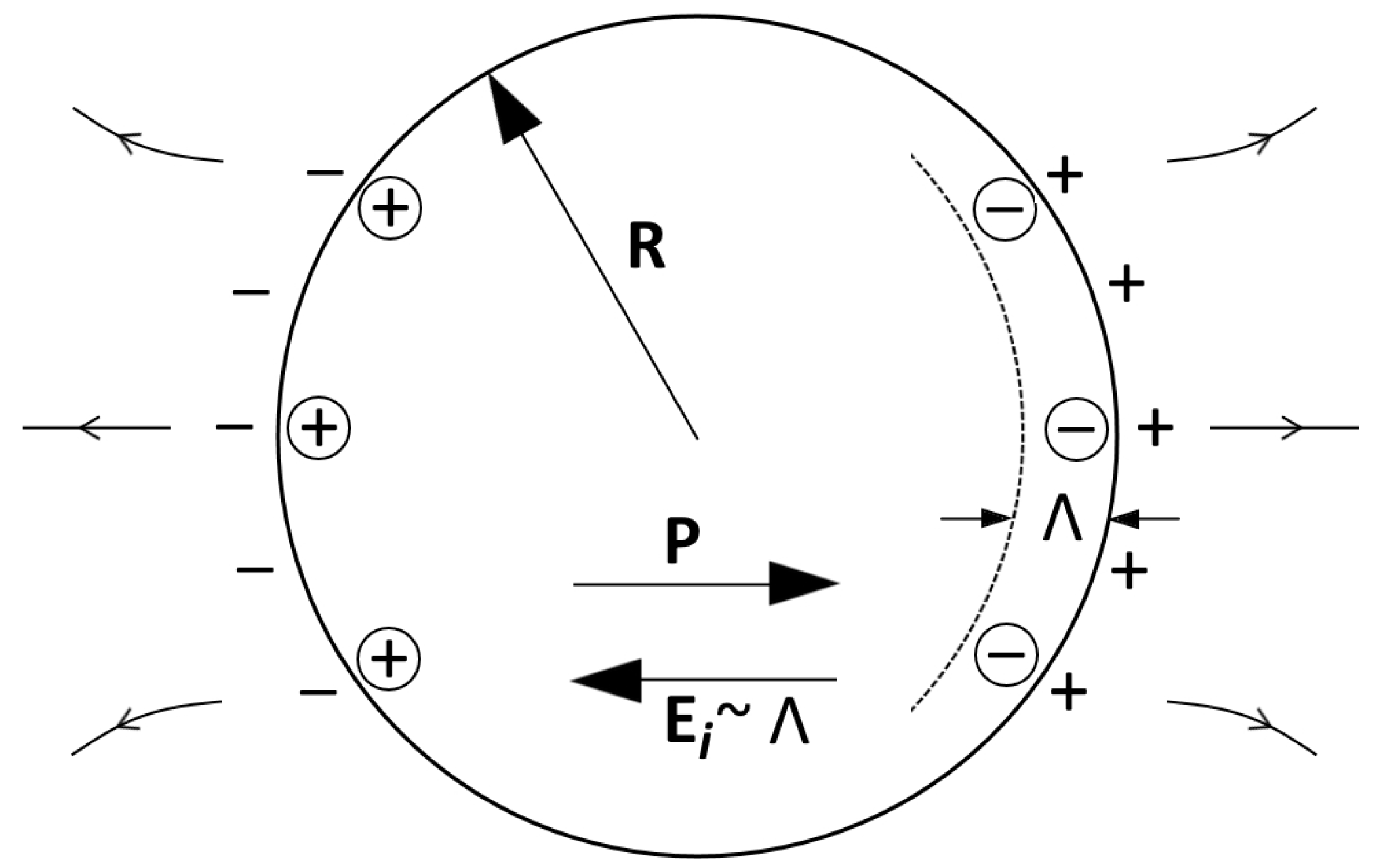Influence of Depolarizing Fields and Screening Effects on Phase Transitions in Ferroelectric Composites
Abstract
:1. Introduction
2. Materials and Methods
3. Results
3.1. The Considered Model and Basic Equations in the Absence of Screening
3.2. The Considered Model and Basic Equations in the Presence of Screening
4. Discussion
Theoretical Estimates and Comparison with Experiment
5. Conclusions
Acknowledgments
Author Contributions
Conflicts of Interest
References
- Scott, J.F. Applications of modern ferroelectrics. Science 2007, 315, 954–959. [Google Scholar] [CrossRef] [PubMed]
- Scott, J.F. Prospects for ferroelectrics: 2012–2022. ISRN Mater. Sci. 2013, 2013, 187313. [Google Scholar] [CrossRef]
- Martin, L.W.; Rappe, A.M. Thin-film ferroelectric materials and their application. Nat. Rev. Mater. 2016, 2, 10087. [Google Scholar] [CrossRef]
- Sengupta, L.C.; Sengupta, S. Breakthrough advances in low loss, tunable dielectric materials. Mater. Res. Innov. 1999, 2, 278–282. [Google Scholar] [CrossRef]
- Yu, K.W.; Hui, P.M.; Stroud, D. Effective dielectric response of nonlinear composites. Phys. Rev. B Condens. Matter 1993, 47, 14150–14156. [Google Scholar] [CrossRef] [PubMed]
- Ploss, B.; Shin, F.G.; Chan, H.L.W.; Choy, C.L. Pyroelectric or piezoelectric compensated ferroelectric composites. Appl. Phys. Lett. 2000, 76, 2776–2778. [Google Scholar] [CrossRef]
- Fokin, A.V.; Kumzerov, Y.A.; Okuneva, N.M.; Naberezhnov, A.A.; Vakhrushev, S.B.; Golosovsky, I.V.; Kurbakov, A.I. Temperature evolution of sodium nitrite structure in a restricted geometry. Phys. Rev. Lett. 2002, 89, 175503–175506. [Google Scholar] [CrossRef] [PubMed]
- Rysiakiewicz-Pasek, E.; Poprawski, R.; Polanska, J.; Urbanowicz, A.; Sieradzki, A. Properties of porous glasses with embedded ferroelectric materials. J. Non-Cryst. Solids 2006, 352, 4309–4318. [Google Scholar] [CrossRef]
- Sherman, V.O.; Tagantsev, A.K.; Setter, N. Ferroelectric-dielectric tunable composites. J. Appl. Phys. 2006, 99, 074104. [Google Scholar] [CrossRef]
- Rogazinskaya, O.V.; Milovidova, S.D.; Sidorkin, A.S.; Popravko, N.G.; Bosykh, M.A.; Enshina, V.S. Dielectric properties of ferroelectric composites with TGS inclusions. Ferroelectrics 2010, 398, 191–197. [Google Scholar] [CrossRef]
- Zhang, Q.; Zhai, J.; Zhang, H.; Yao, X. Microstructure and dielectric property relationships in spherical inclusion ferroelectric composite ceramics. J. Appl. Phys. 2012, 112, 054101. [Google Scholar] [CrossRef]
- Rogazinskaya, O.V.; Milovidova, S.D.; Popravko, N.G.; Sidorkin, A.S.; Naberezhnov, A.A.; Grokhotova, E.V. Repolarization properties of nanocomposites based on porous glass and aluminum oxide with inclusions of sodium nitrite. Ferroelectrics 2013, 444, 107–110. [Google Scholar] [CrossRef]
- Milovidova, S.D.; Rogazinskaya, O.V.; Sidorkin, A.S.; Nguen, K.T.; Grohotova, E.V.; Popravko, N.G. Dielectric properties of the composites based on nanocrystalline cellulose and triglycine sulfate. Ferroelectrics 2014, 469, 116–119. [Google Scholar] [CrossRef]
- Rogazinskaya, O.V.; Sidorkin, A.S.; Popravko, N.G.; Milovidova, S.D.; Naberezhnov, A.A.; Grokhotova, E.V. Dielectric and repolarization properties of nanocomposites based on porous matrix with sodium nitrite. Ferroelectrics 2014, 469, 138–143. [Google Scholar] [CrossRef]
- Rogazinsksya, O.V.; Sidorkin, A.S.; Milovidova, S.D.; Naberezhnov, A.A.; Matveev, N.N.; Popravko, N.G.; Fokin, A.V. Ferroelectricity in nanocomposites based on porous glass with inclusions of NaNO2. Bull. Russ. Acad. Sci. Phys. 2011, 75, 1410–1413. [Google Scholar] [CrossRef]
- Tarnavich, V.; Korotkov, L.; Karaeva, O.; Naberezhnov, A.; Rysiakiewicz-Pasek, E. Effect of restricted geometry on structural phase transitions in KH2PO4 and NH4H2PO4 crystals. Opt. Appl. 2010, 40, 305–309. [Google Scholar]
- Baryshnikov, S.V.; Stukova, E.V.; Charnaya, E.V.; Tien, C.; Lee, M.K.; Böhlmann, B.; Michel, D. Dielectric and NMR studies of nanoporous matrices loaded with sodium nitrite. Phys. Solid State 2006, 48, 593–599. [Google Scholar] [CrossRef]
- Rogazinskaya, O.V.; Milovidova, S.D.; Sidorkin, A.S.; Chernyshev, V.V.; Babicheva, N.G. Properties of nanoporous aluminum oxide with triglycine sulfate and rochelle salt inclusions. Phys. Solid State 2009, 51, 1518–1521. [Google Scholar] [CrossRef]
- Haeni, J.H.; Irvin, P.; Chang, W.; Uecker, R.; Reiche, P.; Li, Y.L.; Choudhury, S.; Tian, W.; Hawley, M.E.; Craigo, B.; et al. Room-temperature ferroelectricity in strained SrTiO3. Nature 2004, 430, 758–761. [Google Scholar] [CrossRef] [PubMed]
- Popravko, N.G.; Sidorkin, A.S.; Milovidova, S.D.; Rogazinskaya, O.V. IR Spectroscopy of ferroelectric composites. Phys. Solid State 2015, 57, 522–526. [Google Scholar] [CrossRef]
- Wang, Y.; Zhong, W.; Zhang, P. Size effect of ferroelectric particles. Sci. China Ser. A 1995, 38, 724–727. [Google Scholar]
- Rychetský, I.; Hudák, O. The ferroelectric phase transition in small spherical particles. J. Phys. Condens. Matter 1997, 9, 4955–4965. [Google Scholar] [CrossRef]
- Rychetský, I.; Hudak, O.; Petzelt, J. Dielectric properties of microcomposite ferroelectrics. Phase Trans. 1999, 67, 725–739. [Google Scholar] [CrossRef]
- Hudak, O. Paraelectric-Ferroelectric phase transitions in small spherical particles. Ferroelectrics 2008, 375, 92–106. [Google Scholar] [CrossRef]
- Nechaev, V.N.; Viskovatykh, A.V. Effect of thermal stresses on the phase transition temperature in a ferroelectric-dielectric nanocomposite. Phys. Solid State 2014, 56, 1992. [Google Scholar] [CrossRef]
- Glinchuk, M.D.; Morozovskaya, A.N. Effect of surface tension and depolarization field on ferroelectric nanomaterial properties. Phys. Status Solidi 2003, 238, 81–91. [Google Scholar] [CrossRef]
- Morozovska, A.N.; Glinchuk, M.D.; Eliseev, E.A. Phase transitions induced by confinement of ferroic nanoparticles. Phys. Rev. 2007, B76, 014102. [Google Scholar] [CrossRef]
- Nguen, K.T. Relaxation Processes in Ferroelectric Composites with a Matrix of Nanocrystalline Cellulose. Ph.D. Thesis, Voronezh State University, Voronezh, Russia, 2016; 21p. [Google Scholar]
- Milovidova, S.D.; Rogazinskaya, O.V.; Sidorkin, A.S.; Poyarkova, T.N.; Bavykin, S.A.; Ionova, E.V. Ferroelectric properties of SiO2–TGS nanocomposite. Bull. Russ. Acad. Sci. Phys. 2010, 74, 1295–1298. [Google Scholar] [CrossRef]

© 2018 by the authors. Licensee MDPI, Basel, Switzerland. This article is an open access article distributed under the terms and conditions of the Creative Commons Attribution (CC BY) license (http://creativecommons.org/licenses/by/4.0/).
Share and Cite
Darinskii, B.; Sidorkin, A.; Sigov, A.; Popravko, N. Influence of Depolarizing Fields and Screening Effects on Phase Transitions in Ferroelectric Composites. Materials 2018, 11, 85. https://doi.org/10.3390/ma11010085
Darinskii B, Sidorkin A, Sigov A, Popravko N. Influence of Depolarizing Fields and Screening Effects on Phase Transitions in Ferroelectric Composites. Materials. 2018; 11(1):85. https://doi.org/10.3390/ma11010085
Chicago/Turabian StyleDarinskii, Boris, Alexander Sidorkin, Alexander Sigov, and Nadezhda Popravko. 2018. "Influence of Depolarizing Fields and Screening Effects on Phase Transitions in Ferroelectric Composites" Materials 11, no. 1: 85. https://doi.org/10.3390/ma11010085




